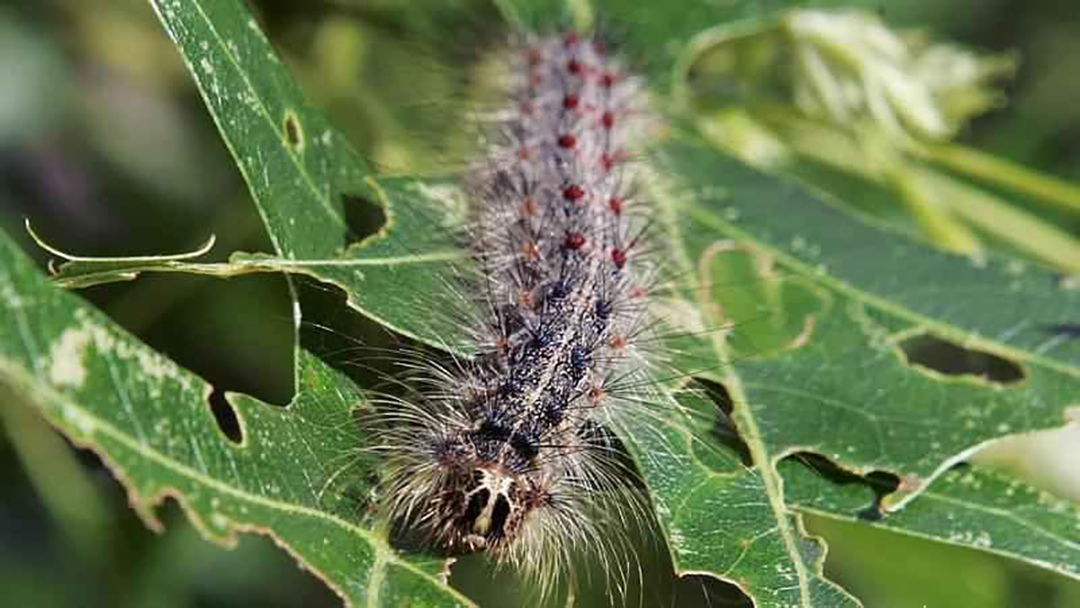By RICK MILLER | Olean Times Herald | Jun 17, 2021
Gypsy moth caterpillar: Leaf-chewing gypsy moth caterpillars have been reported throughout New York state this spring.
A state Department of Environmental Conservation forester said Wednesday that many forests across the state are being defoliated by invasive gypsy moth caterpillars.
In a Zoom meeting with reporters, forester Rob Cole said gypsy moth caterpillar damage has been reported in Western New York. Some defoliation has been reported locally in oak trees along the Allegheny River Valley Trail.
Joseph Snyder, a timber buyer for Fitzpatrick & Weller Co. of Ellicottville, said there appear to be more gypsy moth caterpillars around the county than in 2020, but he has seen no major defoliations this year.
Cole said gypsy moth caterpillars are hitting Clinton, Saratoga, Warren, Ontario, Orleans and Livingston counties the hardest.
The defoliation in parts of the Adirondacks is unusual because they had not been reported in those areas last year, Cole told reporters.
The caterpillars favor oak trees, aspen and willows, but can also eat the foliage of alternate hosts like blue spruce, white pine, maples and hemlock trees.
Cole said in most cases, the trees will re-foliate in July, although successive years of defoliation can kill trees. If blue spruce and white pine are completely defoliated, they can die.
The acorns in oak trees — which many animals depend on for food — are not eaten by the caterpillars and should continue to grow, but possibly in reduced numbers, Cole explained.
Damage from the gypsy moth caterpillars to trees effectively ends after three years when the populations succumb to virus and fungus, Cole said. These are natural enemies that have evolved since the caterpillars escaped from captivity in Massachusetts in the mid-1880s where they had been imported from Europe to make silk.
There is also a commercial product available, BT, a biologic that targets the caterpillar larvae, Cole said. The time for this application has about closed, however, because it is less effective as the caterpillars grow larger. They can grow to about 2 1/2 inches. Some forestry companies that own large tracts of property in the gypsy moth caterpillars’ path will contract for aerial spraying.
For homeowners hoping to save their ornamental trees from the voracious gypsy moth caterpillars, the same BT can be successfully applied to trees in early spring as the tiny caterpillars emerge, Cole said.
Another method of protecting individual trees is to apply a belt of a sticky substance around the tree trunk. Do not apply it directly to the tree, Cole warned. The caterpillars climb up and down the tree trunk and will become stuck to the substance.
In late June, when the caterpillars pupate to become adults, Cole advised homeowners to place a burlap bag around the base of the tree. The caterpillars will go into the burlap, where they can be collected.
Another way to reduce the gypsy moth caterpillar population the following year is to hunt for the light brownish egg masses they lay on houses, trees, fences, furniture and other outdoor surfaces. Scrape them off and drop the egg mass in water, he suggested.
Cole followed the Zoom press conference with a Facebook Live event. To watch on Facebook, go to https://t.co/KYRRn8S2FI
(Contact reporter Rick Miller at rmiller@oleantimesherald.com. Follow him on Twitter, @RMillerOTH)




